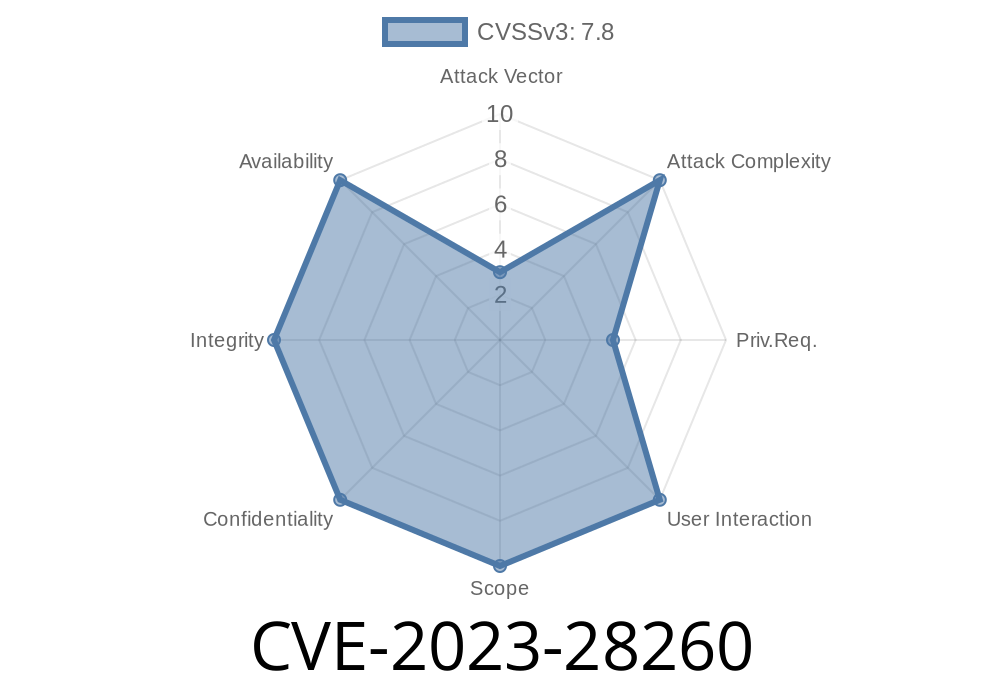DLL hijacking vulnerabilities have long been a concern for security researchers and software developers alike. With the release of CVE-2023-28260, there is a significant new threat that affects applications developed using the .NET framework, potentially allowing a remote attacker to execute arbitrary code on a victim's machine. In this article, we will delve into the technical details of this vulnerability, including code snippets, links to original references, and details on the exploit itself.
Background
The CVE-2023-28260 vulnerability is a .NET DLL Hijacking Remote Code Execution vulnerability affecting applications built with the .NET framework. The issue stems from the way .NET applications handle DLL imports, specifically the loading of DLLs from insecure paths.
This vulnerability requires an attacker to have write access to a specific directory on the target system, from which the vulnerable application loads a malicious DLL. Once loaded, the DLL executes the attacker's payload, typically resulting in remote code execution.
Let's dive into the details of how this vulnerability works and how it can be exploited.
DLL Hijacking in .NET Applications
Dynamic Link Libraries (DLLs) are an integral part of Windows applications, providing reusable code and resources for various functionalities. .NET applications often rely on external DLLs through an import mechanism. However, when the .NET application imports the DLL, it follows a specific search order, as documented by Microsoft here.
Unfortunately, this search order may lead the application to load a malicious DLL in place of the legitimate one. If the application then executes functions from the malicious DLL, the attacker gains control and can run arbitrary code. This is known as DLL Hijacking.
The Exploit Details
First, let's examine the code snippet that demonstrates the core issue of CVE-2023-28260. Suppose we have a .NET application that imports a function from a DLL as shown:
[DllImport("example.dll", CallingConvention = CallingConvention.Cdecl)]
public static extern int ExampleFunction(int a, int b);
This code tells the .NET application to search for the example.dll and import the ExampleFunction function from it. If the application fails to find example.dll in the same directory as the executable, it continues searching in other directories, as dictated by the search order.
Trick the victim into launching the vulnerable .NET application.
Upon execution, the vulnerable application loads the attacker's malicious DLL instead of the legitimate one. As the malicious DLL exports the same functions as the legitimate DLL, the application unwittingly calls functions from the malicious DLL, leading to remote code execution.
Mitigating CVE-2023-28260
The best way to mitigate CVE-2023-28260 is to follow secure programming practices when developing .NET applications. Microsoft recommends using the LOAD_LIBRARY_SEARCH_SYSTEM32 flag when loading DLLs to restrict the search path only to the %SystemRoot%\System32 directory, which reduces the risk of DLL Hijacking. The revised code for importing the DLL securely would look like this:
DllImport("example.dll", CallingConvention = CallingConvention.Cdecl, LoadLibraryExFlags = LoadLibraryExFlags.LOAD_LIBRARY_SEARCH_SYSTEM32)]
public static extern int ExampleFunction(int a, int b);
Developers should also avoid loading DLLs from user-writable directories where possible, and system administrators should ensure that write permissions are locked down to prevent attackers from placing malicious DLLs in commonly used locations.
Conclusion
CVE-2023-28260 presents a significant threat to .NET applications, potentially allowing an attacker to gain remote code execution through a DLL Hijacking attack. By understanding the core issue and following secure programming practices, developers can significantly reduce their exposure to this vulnerability. Being aware of potential attack vectors and implementing proper coding techniques will help protect users, keeping systems safe and secure.
Timeline
Published on: 04/11/2023 21:15:00 UTC
Last modified on: 04/18/2023 20:49:00 UTC
